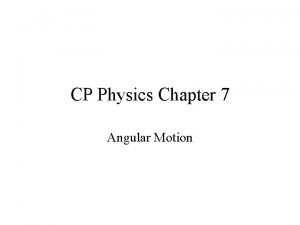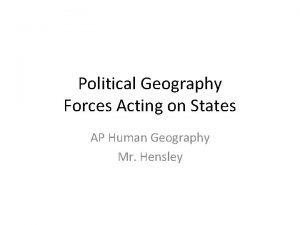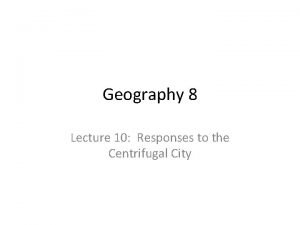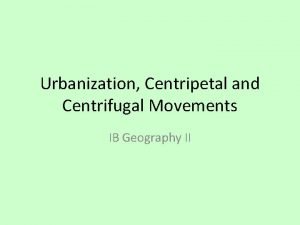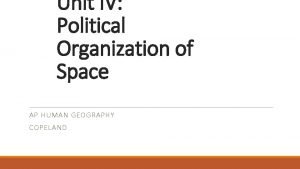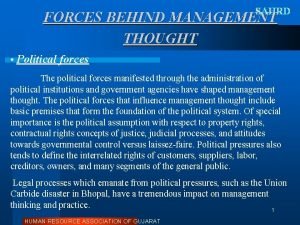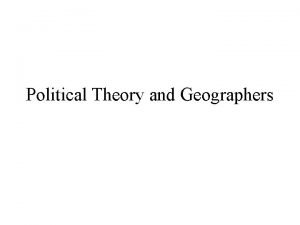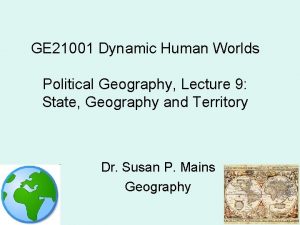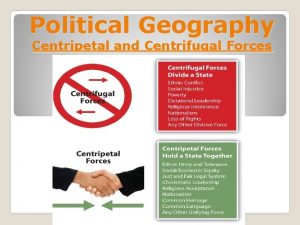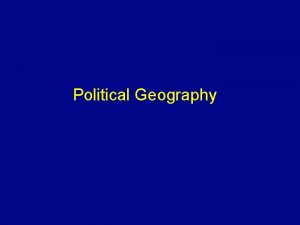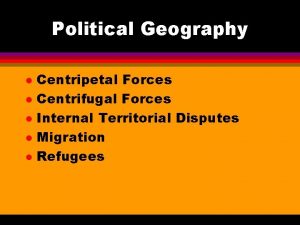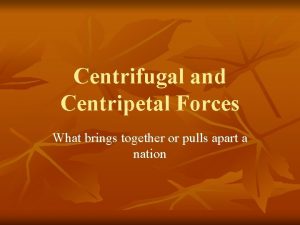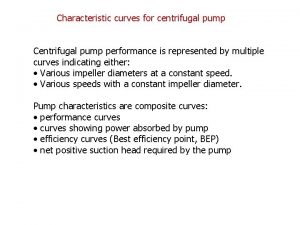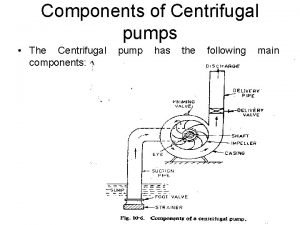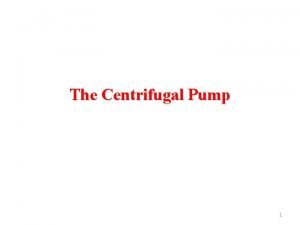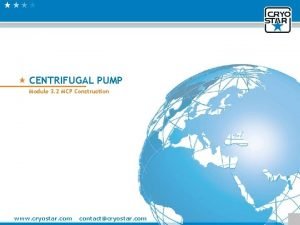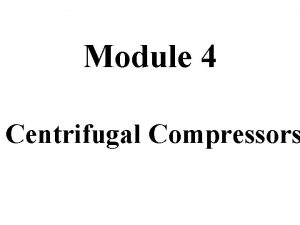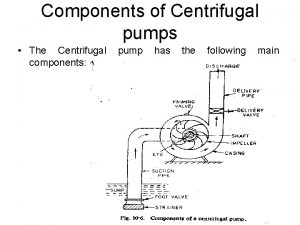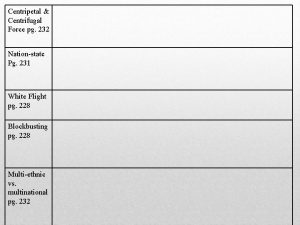Political Geography Centripetal and Centrifugal Forces Centripetal forces



















- Slides: 19

Political Geography

Centripetal and Centrifugal Forces

Centripetal forces vs. Centrifugal force • Attitude or force that unifies and • Attitude or force that enhances support for state divides a state a single native language or a colonial “official” language – English in India, Nigeria revived Hebrew in Israel homogeneous cultural factors - Catholicism in Poland - Hinduism in India - nation-states language religion and ethnicity patriotism, national symbols (anthems, flags, sports teams) - 1980 Miracle on Ice nationalism many native languages – India, Canada, Nigeria or almost all African countries heterogeneous cultural factors - Islam/Christianity in Nigeria - Islam/Hinduism in India - “ethnicities” in Rwanda desire for self-determination in multinational states (Yugoslavia)

Ethnicities compete to dominate states in Africa • African borders do NOT correspond to ethnic groups – Legacy of imperialism – Scramble for Africa – SUPERIMPOSED!

Ethnicities compete to dominate states in Africa

Ethnicities compete to dominate states in Africa multilingual state interfaith conflict + political corruption terrorism unequal resources Nigeria (you should research these issues so you can provide depth on the Final FRQ)

Ethnic Conflict in Africa • Rwanda – Hutu vs. Tutsi – ethnic divisions more “created” than real • hierarchy created by colonial Belgians – social construct • Tutsi made “privileged” – Hutus resent → – take revenge in 1994

What Is Ethnic Cleansing? • process in which a more powerful ethnic group forcibly removes a less powerful group from their territory – purpose is not to subjugate, but to remove – Today, mostly happens in Europe and Africa

Ethnic cleansing and genocide in Rwanda (1994)

Aftermath of Rwandan Genocide • Ethnic conflict spills into neighboring countries • destabilizes Central Africa • Dem. Rep. of Congo falls into civil war – most war deaths (5. 4 m) since WWII – failed state? • a state whose political or economic system has become so weak that the government is no longer in control.

Ethnicities compete to dominate states in Africa • Somalia – “clans” – Islamic militias – US intervention • Black Hawk Down – “failed state” • Piracy – “balkanized” (adj. ) = area that can’t stabilize due to ethnic conflict

• Ethnicities compete to dominate states in Africa Sudan – Govt. in Khartoum = Arab/Muslim • Darfur targeted – Black Muslim – Genocide or ethnic cleansing? – “breakaway” South Sudan • balkanized! • Black, Christian/Animist • Economic – OIL!!!! • Independent 2011 • Now ethnic strife • Failed state?

Ethnic cleansing in Europe – WWII (1939 – 45) • Largest forced migration • Jews, gypsies, and others forcibly removed by Nazis – Post - WWII • Germans, others forced to “relocate” after war • Goals: – USSR buffer zone – Nation-state ideal

Ethnic cleansing in Europe • breakup of Yugoslavia – “balkanization” = breakdown of state due to ethnic conflict – death of Tito – what kind of force was he? • Ethnic cleansing – Bosnia (1992 – 95) – Kosovo (1999) • Albanians cleansed by Serbs • Stopped by NATO airstrikes

Ethnicities compete to dominate states • Lebanon = religious – civil war since 1975 – Israeli and Syrian military interventions

Iraq • • Other ethnicity issues in the Middle East 20% Sunni (Arabic, Saddam Hussein, oppressed/gassed other groups) 60% Shi’a (Arabic but tied to Iran, militias) 20% Kurds (non-Arabic, Sunni, national group, functions as autonomous, US-allied) US invasion unleashes centrifugal forces • Sunnis now out of power become radicalized • Terrorism → Al Qaeda, now ISIS

Centripetal forces a common enemy may help to unite a people » anti-British sentiment during Revolutionary War » U. S. during the Cold War or after 9/11 Democracy can inspire civic participation Dictatorships can stifle dissent and other centrifugal forces - Tito in Yugoslavia - Communist party (USSR) vs. Outside influences Leadership or government (be wary of morality here) (see later slides for internal govt. structure) Centrifugal force irredentism superpower meddling (Africa, Latin America, Asia) » funding rebels, etc. poor governance corruption inequality incompetence » US? ? dictatorship » Arab Spring (2011 – » Assad in Syria

Centripetal forces Mountain ranges, oceans, deserts etc. can limit outside influences and bind a country together » Egypt along the Nile vs. Physical Features More advanced countries have things like airports, railroads and highways Infrastructure which allow people to remain in contact, people to move within the country, etc. Centrifugal force Shape of state (see later) and internal physical features can separate populations and lead to separatism » Russia’ vastness has been a centrifugal force throughout its history » Nepal’s mountains separate communities Less developed countries lack infrastructure. This may isolate areas and become a centrifugal force.

 Centrifugal force in geography
Centrifugal force in geography Centripetal vs centrifugal
Centripetal vs centrifugal Centrifugal ap human geography
Centrifugal ap human geography Centripetal forces ap human geography
Centripetal forces ap human geography Centripetal acceleration formula
Centripetal acceleration formula Ap human geography political geography frq
Ap human geography political geography frq Ap human geography political geography test
Ap human geography political geography test New urbanism ap human geography definition
New urbanism ap human geography definition Centripetal movement geography
Centripetal movement geography Compact state geography definition
Compact state geography definition Relationship between political science and geography
Relationship between political science and geography Various forces behind management thought
Various forces behind management thought Advantages of permanent mold casting
Advantages of permanent mold casting Genetic classification of boundaries by hartshorne
Genetic classification of boundaries by hartshorne Objectives of political geography
Objectives of political geography Political geography of australia
Political geography of australia European map 1990
European map 1990 Political geography
Political geography Political geography
Political geography Political geography
Political geography

